Serving 1,537 students in grades 9-12, Alamo Heights High School ranks in the top 20% of all schools in Texas for overall test scores (math proficiency is top 30%, and reading proficiency is top 30%).
The percentage of students achieving proficiency in math is 51% (which is higher than the Texas state average of 41%). The percentage of students achieving proficiency in reading/language arts is 69% (which is higher than the Texas state average of 51%).
The student:teacher ratio of 13:1 is lower than the Texas state level of 14:1.
Minority enrollment is 47% of the student body (majority Hispanic), which is lower than the Texas state average of 75% (majority Hispanic).
Quick Stats (2025)
- Grades: 9-12
- Enrollment: 1,537 students
- Student:Teacher Ratio: 13:1
- Minority Enrollment: 47%
- Graduation Rate: 98% (Top 5% in TX)
- Overall Testing Rank: Top 20%
- Math Proficiency: 51% (Top 30%)
- Reading Proficiency: 69% (Top 20%)
- Science Proficiency: 71% (Top 10%)
- Source: National Center for Education Statistics (NCES), TX Dept. of Education
Top Rankings
Alamo Heights High School ranks among the top 20% of public schools in Texas for:
Category
Attribute
Overall Rank
Reading/Language Arts Proficiency
Science Proficiency
Graduation Rate
School Overview
Alamo Heights High School's student population of 1,537 students has stayed relatively flat over five school years.
The teacher population of 120 teachers has stayed relatively flat over five school years.
Grades Offered
Grades 9-12
Total Students
1,537 students
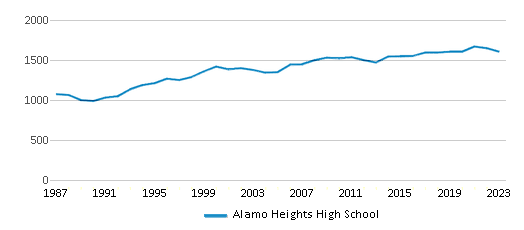
Gender %
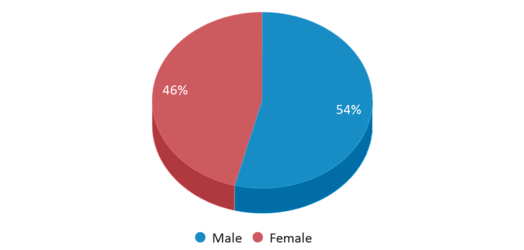
Total Classroom Teachers
120 teachers
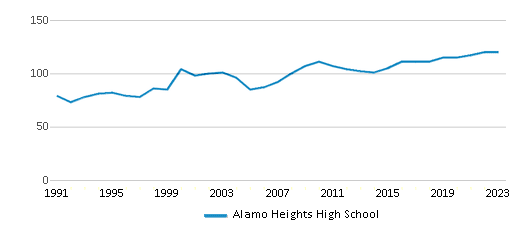
Students by Grade
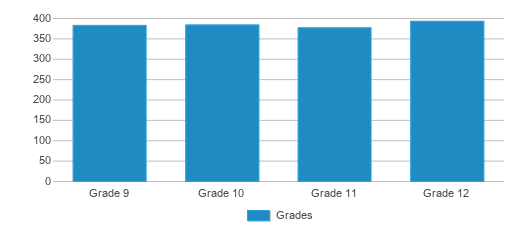
School Rankings
Alamo Heights High School ranks within the top 20% of all 8,188 schools in Texas (based off of combined math and reading proficiency testing data).
The diversity score of Alamo Heights High School is 0.56, which is less than the diversity score at state average of 0.64. The school's diversity has stayed relatively flat over five school years.
Overall Testing Rank
#1559 out of 8188 schools
(Top 20%)
(Top 20%)
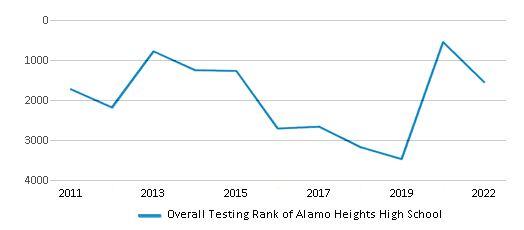
Math Test Scores (% Proficient)
51%
41%
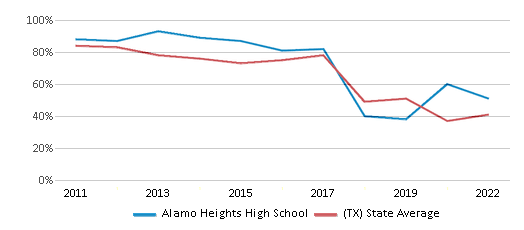
Reading/Language Arts Test Scores (% Proficient)
69%
51%
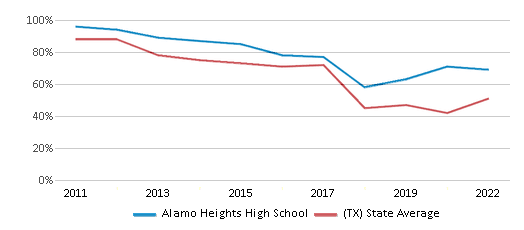
Science Test Scores (% Proficient)
71%
46%
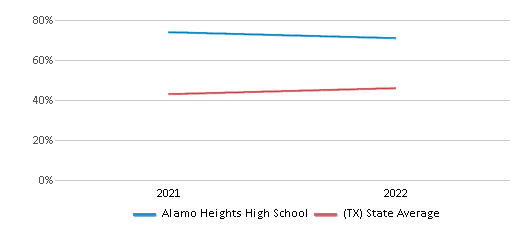
Student : Teacher Ratio
13:1
14:1
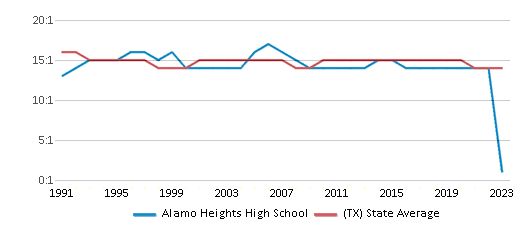
American Indian
1%
n/a
Asian
3%
6%
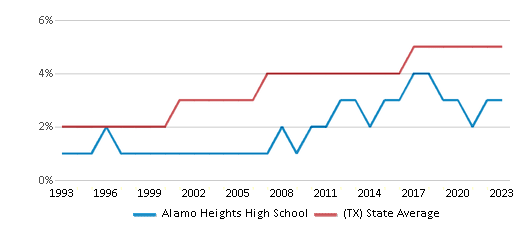
Hispanic
40%
53%
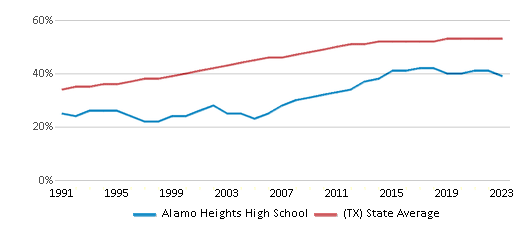
Black
2%
13%
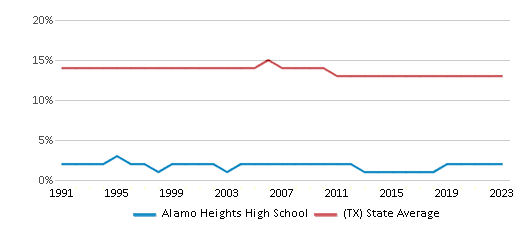
White
53%
25%
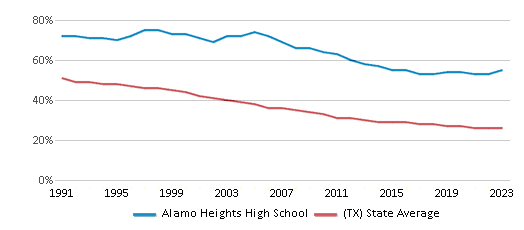
Hawaiian
n/a
n/a
Two or more races
1%
3%
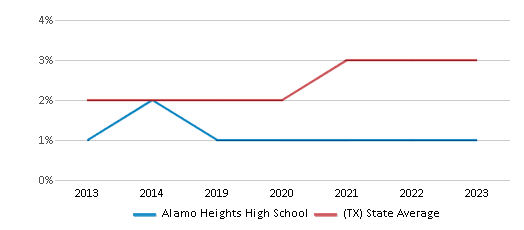
All Ethnic Groups
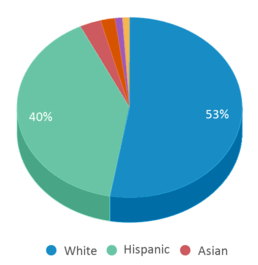

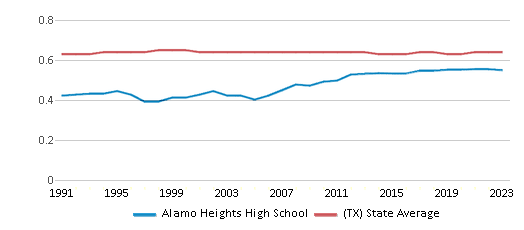
Graduation Rate
98%
90%

Participates in the National School Lunch Program (NSLP)
Yes
Eligible for Free Lunch
15%
57%
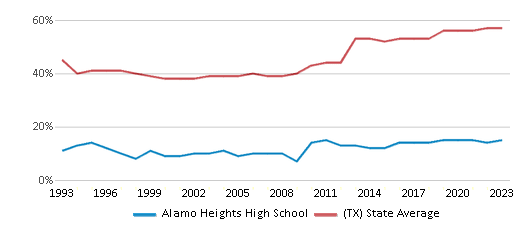
Eligible for Reduced Lunch
3%
5%
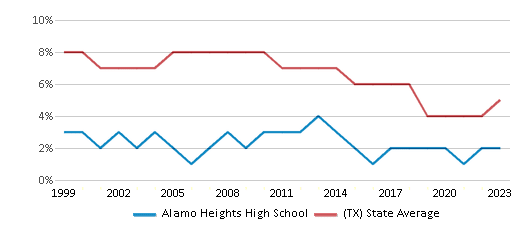
School Statewide Testing
School District Name
Source: National Center for Education Statistics (NCES), TX Dept. of Education
Profile last updated: 02/09/2025
Frequently Asked Questions
What is Alamo Heights High School's ranking?
Alamo Heights High School is ranked #1559 out of 8,188 schools, which ranks it among the top 20% of public schools in Texas.
What schools are Alamo Heights High School often compared to?
Alamo Heights High Schoolis often viewed alongside schools like Reagan High School by visitors of our site.
What percent of students have achieved state testing proficiency in math and reading?
51% of students have achieved math proficiency (compared to the 41% TX state average), while 69% of students have achieved reading proficiency (compared to the 51% TX state average).
What is the graduation rate of Alamo Heights High School?
The graduation rate of Alamo Heights High School is 98%, which is higher than the Texas state average of 90%.
How many students attend Alamo Heights High School?
1,537 students attend Alamo Heights High School.
What is the racial composition of the student body?
53% of Alamo Heights High School students are White, 40% of students are Hispanic, 3% of students are Asian, 2% of students are Black, 1% of students are American Indian, and 1% of students are Two or more races.
What is the student:teacher ratio of Alamo Heights High School?
Alamo Heights High School has a student ration of 13:1, which is lower than the Texas state average of 14:1.
What grades does Alamo Heights High School offer ?
Alamo Heights High School offers enrollment in grades 9-12
What school district is Alamo Heights High School part of?
Alamo Heights High School is part of Alamo Heights Independent School District.
In what neighborhood is Alamo Heights High School located?
Alamo Heights High School is located in the Uptown neighborhood of San Antonio, TX. There are 16 other public schools located in Uptown.
School Reviews
5 4/1/2020
Very good school in many possible ways.
5 3/30/2020
Even though it was a long, long time ago, I still cherish my attendance at Alamo Heights High School. The academic, activities and athletic part of my high school was always aimed at success and I feel that it has helped me greatly in the many years of my life since I graduated. Having been to my last two class reunions even though I have had to fly from Utah to attend, I can tell that AHHS has continued to be a successful experience and I am so glad to learn that things are still going well at the school I loved when I attended there.
Review Alamo Heights High School. Reviews should be a few sentences in length. Please include any comments on:
- Quality of academic programs, teachers, and facilities
- Availability of music, art, sports and other extracurricular activities
Recent Articles

What Is A Charter School?
Explore the world of charter schools in this comprehensive guide. Learn about their history, how they operate, and the pros and cons of this educational innovation. Discover key facts about charter schools, including admission policies, demographics, and funding, as well as what to look for when considering a charter school for your child.

10 Reasons Why High School Sports Benefit Students
Discover the 10 compelling reasons why high school sports are beneficial for students. This comprehensive article explores how athletics enhance academic performance, foster personal growth, and develop crucial life skills. From improved fitness and time management to leadership development and community representation, learn why participating in high school sports can be a game-changer for students' overall success and well-being.

February 05, 2025
Understanding the U.S. Department of Education: Structure, Impact, and EvolutionWe explore how the Department of Education shapes American education, from its cabinet-level leadership to its impact on millions of students, written for general audiences seeking clarity on this vital institution.









